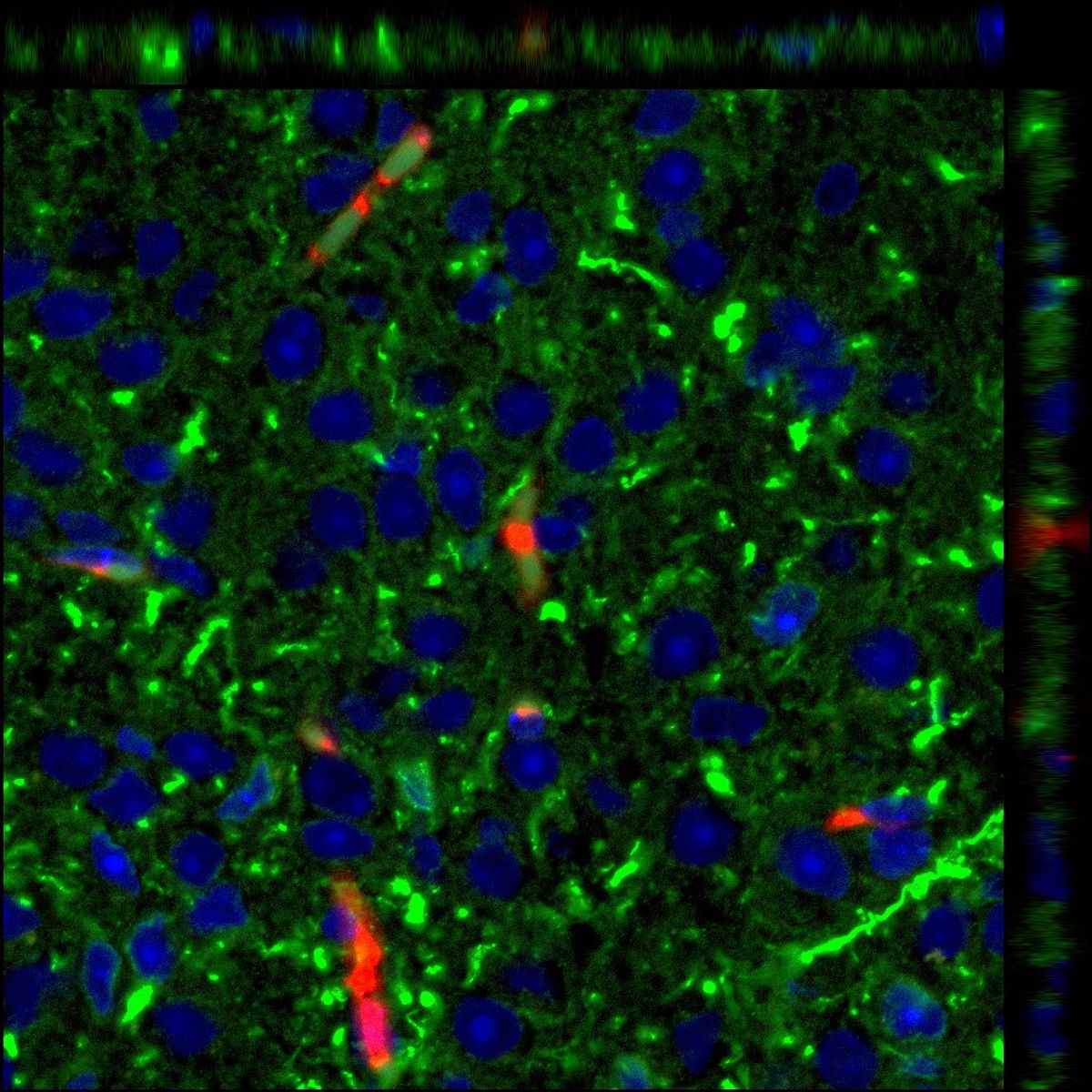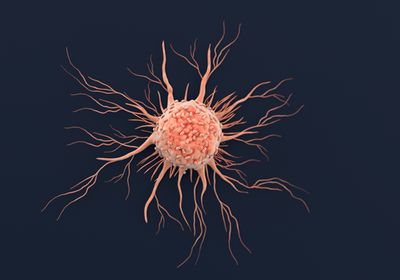ABOVE: Breast cancer cells have a high tendency to migrate to the brain. Scientists show that the microRNAs secreted by the cancer cells aids this behavior. ©istock, luismmolina
The incidence of breast cancer in women has increased significantly over the past few decades, but advancements in targeted therapies have led to a decrease in death rates. Although systemic treatments like chemotherapy are effective at eliminating cancer cells throughout the body, they are unable to penetrate the brain, leaving it vulnerable to metastasis. Fifty percent of patients with breast cancer who receive pharmacotherapy develop metastases to distant organs. Of these, at least 10 to 16 percent have brain metastases.1 To survive in this new environment, cancer cells need to get creative.
“It's not that easy for cells to grow in the brain,” said Marsha Rosner, a cancer biologist at the University of Chicago. “They need some help.”
Recent studies have shown that cancer cells secrete extracellular vesicles (EVs) that aid metastases.2 These small cargo carriers traffic a myriad of molecules, key of which are microRNAs. However, it was unclear how these contents contributed to metastasis.
“If cancer cells do all this work to make the microRNA and secrete them, they're not throwing away some garbage randomly,” said Shizhen Emily Wang, a cancer biologist at the University of California, San Diego. “They must do this for a purpose.”
Now, in a study published in Nature Communications, Wang and her colleagues showed how EVs originating from breast cancer cells deliver microRNAs to brain cells to facilitate metastases.3 The study described a mechanism that other migrating cancers may also use to access the brain and brought forth a potential biomarker for breast cancers that exhibit proclivity for brain metastases.
“It's a new mechanism by which brain cells are reprogrammed for cancer,” said Rosner, who was not involved in the study.
More than a decade ago, reports started to emerge about the presence of microRNAs in the blood. It was well-established that levels of microRNAs are often altered in cancers, leading to a collective push to understand if serum microRNAs are reliable biomarkers for cancer. Previous studies also showed that microRNAs from cancer cells can modulate the behavior of cells in foreign tissues to make the environment more hospitable for their growth.4 Wang, who studies cell signaling pathways in breast cancer, wanted to delve deeper and explore whether microRNAs secreted from breast cancer cells drove metastases.
To test this, Wang and her team collected EVs from either breast cancer or non-cancer cells and introduced them intravenously, along with breast cancer cells, into mice. They found that only EVs secreted by cancer cells triggered metastases of the cancer cells to distant organs. They wanted to know if there was something about the microRNAs in cancer cell EVs that was triggering metastases. So, the researchers profiled the microRNAs in the serum of patients with metastatic breast cancer, half of whom had brain metastases. Four microRNAs showed higher expression in patients with brain metastases relative to patients whose cancers spread to other organs. However, the team did not know whether any of these microRNAs originated from EVs. To answer this question, they extracted EVs from a breast cancer cell line that exhibits a tendency to migrate to the brain and analyzed their microRNA contents.5 They found a significant increase in one of the four microRNAs: miR-199b. When Wang searched microRNA-target databases, she came upon hundreds of potential genes that miR-199b modulates.
“I probably only recognized a dozen,” Wang recounted. She was at a loss as to how to make sense of their findings.

By focusing on genes that are crucial for brain cell functioning, the authors narrowed down the long list of candidate genes. When they applied this criterium to an algorithm that scanned through the possible target sequences of miR-199b, the authors landed on three genes, all of which are involved in regulating metabolic crosstalk between brain cells: solute carrier family 1 member 2 (SLC1A2), solute carrier family 38 member 2 (SLC38A2), and solute carrier family 16 member 7 (SLC16A7).
“It's not a single gene. It's really a circuit that is very important for brain function. That was the most exciting moment for us during the entire study,” Wang said.
These three genes encode membrane proteins that transport different metabolites between brain cells, providing them with energy. In the brain, one way that neurons communicate with one another is through secretion of glutamate. Astrocytes, a type of glial cell, mop up extra glutamate, convert it to glutamine—the precursor for glutamate—and cycle it back to neurons to replenish their stores. This process also protects neurons from the toxic effects of prolonged exposure to glutamate. The three miR-199b-targeted solute carrier proteins work in concert to orchestrate this glutamate recycling program. In metastatic breast cancer, miR-199b tweaks this metabolic highway to feed the cancer.
Once they had this network in focus, Wang and her team zoomed in on how miR-199b adjusts the levels of the levels of the metabolites and their transporters. They treated cultured astrocytes and neurons with EVs that had high levels of either miR-199b or a microRNA that was not present in high levels in patients with brain metastases. Only miR-199b EVs downregulated the levels of all three genes. The cells bathed in miR-199b EVs also consumed less glutamate, glutamine, and lactate. When the team introduced an anti-miR-199b molecule or overexpressed the solute carrier genes, the cultured cells’ metabolite consumption went back up. Next, the authors primed brain slices collected from mice with miR-199b EVs and transplanted breast cancer cells onto them. They observed that the cancer cells grew more rapidly in the presence of miR-199b compared to EVs shuttling other microRNAs.
When Wang and her team injected mice with miR-199b EVs originating from breast cancer cells and analyzed their brains, they found higher levels of glutamine and lactate relative to controls. To check if the higher availability of nutrients enhanced metastases of cancer cells, they injected mice with miR-199b EVs and transplanted breast cancer cells into mammary tissues. After five weeks, the authors observed high levels of brain metastases in these mice, while the primary breast tumor did not grow significantly.
Previously, scientists have shown that microRNAs in EVs of brain metastatic cancer cells can promote the breakdown of the blood-brain barrier and suppress glucose metabolism by normal cells in favor of glucose consumption by cancer cells.6,7 This study adds another key step in brain metastasis, showing how microRNAs can manipulate cells to make more nutrients available for their growth.
“We're learning that metabolism is probably very important for metastasis in general,” Rosner said. As to how common this mode of colonizing new tissue is, she added, “I would guess that it's not limited to breast cancer.”
- Lin NU, et al. CNS metastases in breast cancer.J Clin Oncol. 2004;22(17):3608-3617.
- Peinado H, et al. The secreted factors responsible for pre-metastatic niche formation: Old sayings and new thoughts.Semin Cancer Biol. 2011;21(2):139-146.
- Ruan X, et al. Breast cancer cell-secreted miR-199b-5p hijacks neurometabolic coupling to promote brain metastasis.Nat Commun. 2024;15(1):4549.
- Solé C, Lawrie CH. MicroRNAs in metastasis and the tumour microenvironment.Int J Mol Sci. 2021;22(9):4859.
- Yoneda T, et al. A bone-seeking clone exhibits different biological properties from the MDA?MB?231 parental human breast cancer cells and a brain-seeking clone in vivo and in vitro.J Bone Miner Res. 2001;16(8):1486-1495.
- Tominaga N, et al. Brain metastatic cancer cells release microRNA-181c-containing extracellular vesicles capable of destructing blood–brain barrier.Nat Commun. 2015;6(1):6716.
- Fong MY, et al. Breast-cancer-secreted miR-122 reprograms glucose metabolism in premetastatic niche to promote metastasis.Nat Cell Biol. 2015;17(2):183-194.




